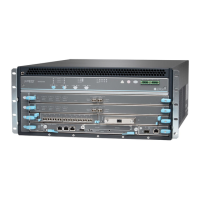•
CompactFlash card—Provides primary storage for software images, configuration files, and microcode.
The CompactFlash card is fixed and is inaccessible from outside the device.
•
Solid-state drive (SSD)—Provides secondary storage for log files, for generating core files, and for rebooting
the system if the CompactFlash card fails.
•
Interface ports—The AUX, CONSOLE, and ETHERNET ports provide access to management devices.
Each Routing Engine has one 10/100/1000-Mbps Ethernet port for connecting to a management
network, and two asynchronous serial ports—one for connecting to a console and one for connecting
to a modem or other auxiliary device.
•
EEPROM—Stores the serial number of the Routing Engine.
•
Reset button—Reboots the Routing Engine when pressed.
•
Online/Offline button—Takes the Routing Engine online or offline when pressed.
•
Extractor clips—Inserts and extracts the Routing Engine.
•
Captive screws—Secures the Routing Engine in place.
Routing Engine for SRX5400, SRX5600, and SRX5800 Services Gateways
Description
Junos OS Release 12.1X47-D15 and later
Software release
Slot for Routing Engine
•
AUX–Connects the Routing Engine to a laptop, a modem, or another auxiliary
device through a cable with an RJ-45 connector.
•
CONSOLE–Connects the Routing Engine to a system console through a cable with
an RJ-45 connector.
•
ETHERNET–Connects the Routing Engine through an Ethernet connection to a
management LAN (or any other device that plugs into an Ethernet connection) for
out-of-band management.
Cables and connectors
RESET button–Reboots the Routing Engine when pressed.
Controls
Front panel slot in an SCB installed in:
•
SRX5400: Bottom slot 0
•
SRX5600: Bottom slots 0 or 1
•
SRX5800: Center slots 0 or 1
NOTE: The services gateway host subsystem Routing Engine must be installed in the
SCB in slot 0. A Routing Engine installed in an SCB in slot 1 only enables dual control
links in chassis cluster configurations.
Supported slots
90 W
Power requirement
81

